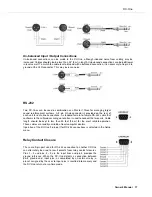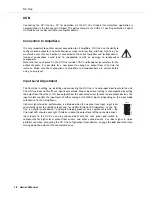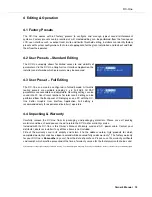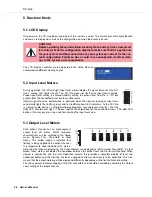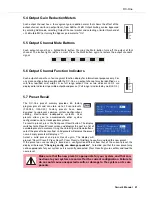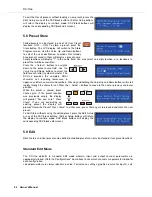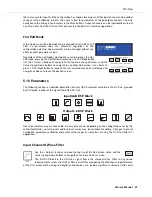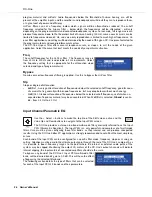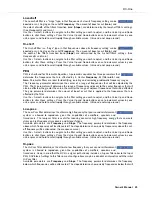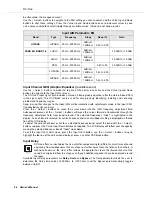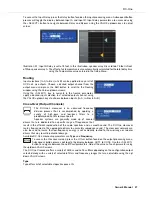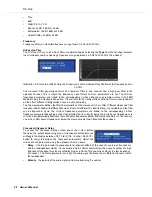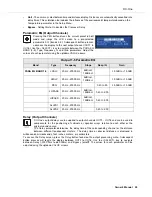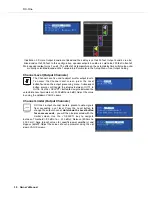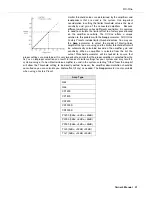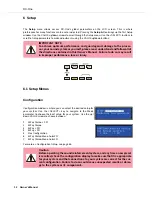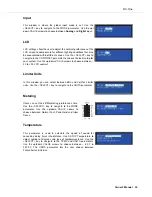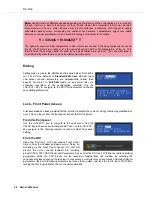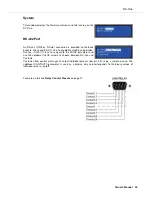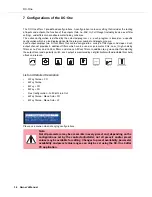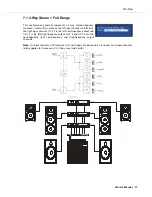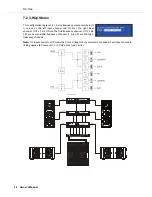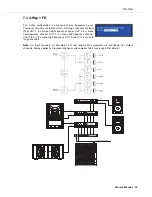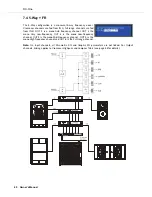
DC-One
Owner‘s Manual 25
Low-shelf
The Low-shelf filter is a “hinge” type; in that frequencies
below
its frequency setting can be
boosted or cut; hinging on the cut-off
Frequency
. The amount of boost or cut (
Gain
), and
the extent of width of the filter’s transition band (
Slope
), are determined by the low-shelf filter’s settings.
(See Response/Q and Gain.)
Use the < Select > buttons to navigate to the filter setting you wish to adjust, and the Value Up and Down
buttons to alter these settings. Press the Value Up and Down buttons once to increment values by one
unit, or press and hold to scroll rapidly through available values. (Values do not wrap around.)
Hi-shelf
The Hi-shelf filter is a “hinge” type; in that frequencies above its frequency setting can be
boosted or cut; hinging on the cut-off
Frequency
. The amount of boost or cut (
Gain
), and
the width of the filter’s transition band (
Slope
), are determined by the hi-shelf filter’s settings. (See
Response/Q and Gain.)
Use the < Select > buttons to navigate to the filter setting you wish to adjust, and the Value Up and Down
buttons to alter these settings. Press the Value Up and Down buttons once to increment values by one
unit, or press and hold to scroll rapidly through available values. (Values do not wrap-around.)
PEQ
PEQ is shorthand for Parametric Equalizer. A parametric equalizer has three parameters that
determine the frequencies that are affected by it; Center
Frequency
,
Q
(filter-width) and
Gain
. Parametric filters are ideal for identifying, isolating and correcting problematic frequency ranges.
The Frequency parameter determines the center of a range of frequencies that will be adjusted by the
PEQ. The Q parameter will determine the range of frequencies adjacent to the center frequency that will
also be effected; the greater the value, the smaller the range of adjacent frequencies that will be effected.
The gain parameter determines the amount of boost or cut that is applied to the frequencies that are
affected by the filter.
Use the < Select > buttons to navigate to the filter setting you wish to adjust, and the Value Up and Down
buttons to alter these settings. Press the Value Up and Down buttons once to increment values by one
unit, or press and hold to scroll rapidly through available values. (Values do not wrap-around.)
Low-pass
The Low-Pass filter determines the ultimate high frequency that your sound reinforcement
system is allowed to reproduce; given the capabilities of amplifiers, speakers and
transducers. The low-pass filter is useful for reducing excessive high frequency energy that can create
stress on high frequency transducers and listener fatigue.
Available parameters are
Frequency
and
Slope
. The frequency parameter determines the frequency
above which frequencies will be attenuated. The slope determines how quickly frequencies above the cut-
off frequency will be attenuated. (See response curve.)
Use the < Select > buttons to navigate to the filter setting you wish to adjust, and the Value Up and Down
buttons to alter these settings. Press the Value Up and Down buttons once to increment values by one
unit, or press and hold to scroll rapidly through available values. (Values do not wrap-around.)
Hi-pass
The Hi-Pass filter determines the ultimate low frequency that your sound reinforcement
system is allowed to reproduce; given the capabilities of amplifiers, speakers and
transducers. Keep in mind that the DC-One signal path already includes a hi-pass filter prior to the Input
PEQ DSP block. Settings to this filter in most configurations may be redundant or interactive with the initial
Hi-Pass filter.
Available parameters are
Frequency
and
Slope
. The frequency parameter determines the frequency
below which frequencies will be attenuated. The slope determines how quickly frequencies below that will
Summary of Contents for DC-One
Page 5: ...DC One Owner s Manual 5...
Page 6: ...DC One 6 Owner s Manual 1 Overview...
Page 7: ...DC One Owner s Manual 7...
Page 43: ...DC One 98 Owner s Manual Bedienungsanleitung 10 5 Bessel Filters 10 6 Butterworth Filters...
Page 45: ...DC One 100 Owner s Manual Bedienungsanleitung 10 9 PEQ Gains...
Page 46: ...DC One Owner s Manual Bedienungsanleitung 101...
Page 47: ...Notes...
Page 48: ...Notes...







